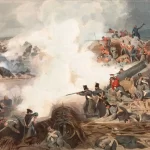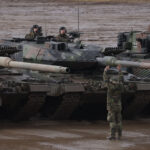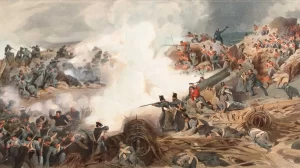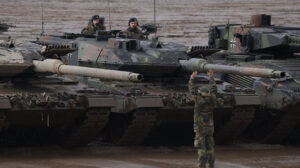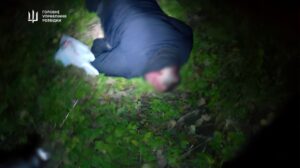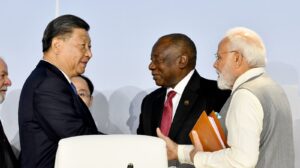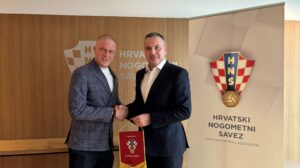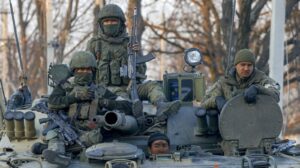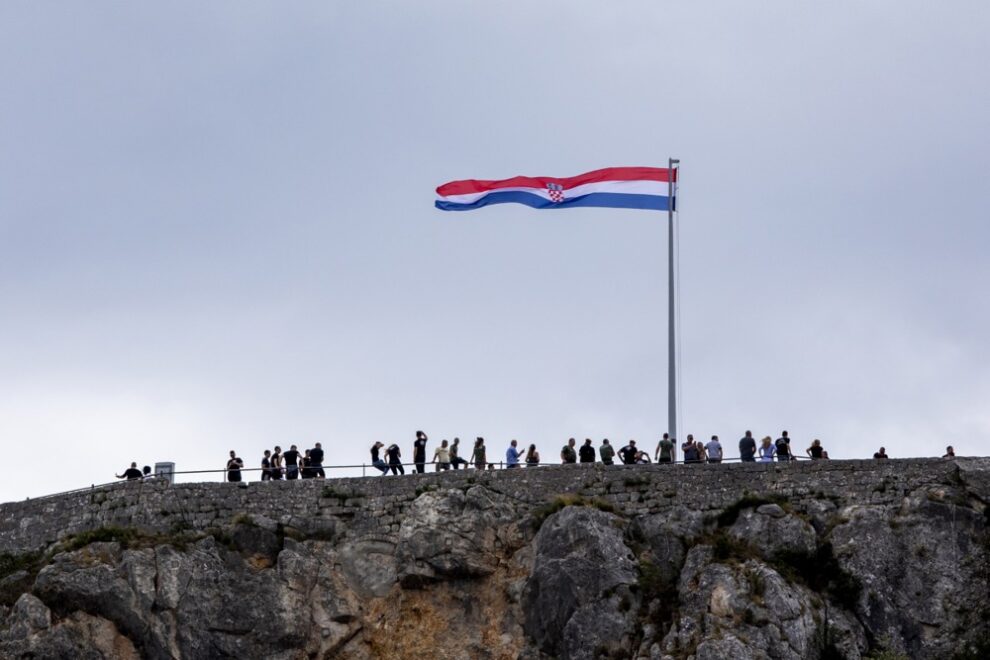In the days before the anniversary of Operation Storm this week, Croatian media announced the order of ceremonies for this year’s event to mark what is known in the country as Victory and Homeland Thanksgiving Day: the laying of wreaths, speeches by political and military leaders, a Catholic mass and an evening concert, all shown live on national television.
While commemorations of the anniversary in Croatia and Serbia have become more elaborate over time, media coverage in both countries has continued to follow familiar themes that date back to the 1990s war years.
Operation Storm, which started at 5am on August 4, 1995, saw the Croatian Army liberate a large part of the Croatian territory that had been under the control of rebel Serbs since 1991.
Croatian forces achieved their military goals in just three days, ousting the rebel Serbs’ unrecognised statelet, the Republic of Serbian Krajina. The anniversary is marked each year as a national triumph, with mainstream media echoing the celebratory patriotic theme.
In Serbia however, the mainstream media narrative is very different. Operation Storm is seen by Belgrade as a tragedy because it caused a huge exodus of Serb civilians from Croatia; several hundred Serbs were also killed. Many Serbian media reflect the official mood of mourning; the government’s memorial ceremony for the victims is shown live on national television.
In Croatia, veteran political and media analyst Zarko Puhovski said that the general narrative on which the ‘truth’ about Operation Storm was based has three elements.
Firstly, the generally accepted narrative is that Operation Storm was a justified action that was actually defensive, although tactically it was offensive, Puhovski said. Secondly, the Serbs left Croatia led by or at the request of their leaders, and thirdly, it was a military action that was carried out in an exemplary manner, he added.
“Four years ago, then [then] Croatian president [Kolinda Grabar Kitarovic] said that it was a victory without a single blemish, literally. Now it is said that [it happened] ‘with some minor incidents’,” he said, adding that he does not expect the Croatian public’s perception to change.
“In Croatia in the 2000s, critical news could be heard about the behaviour of the Croatian Army in [Operation] Storm. Paradoxically, after Croatia’s entry into the EU [in 2013], the situation suddenly worsened,” he recalled.
Puhovski believes that the political and mainstream media narratives about Operation Storm are actually similar in Croatia and Serbia.
“Both sides have the same pattern, which reads: For them, the crimes were part of official policy, and for us, they were isolated incidents. This is what each of them says about the other,” he said.
He argued that the paradox in Croatian-Serbian relations is that in the last ten years, nationalist rhetoric has intensified, instead of softening with the passage of time.
One of the rare incidents in which Croatian media published material about the refugee exodus of Serbs from the country was in the summer of 2020, when Anja Simpraga, a member of the Independent Democratic Serbian Party, which represents the remaining Croatian Serbs’ political interests, gave an emotional speech to the Croatian parliament about her experience as a child fleeing the war.
However, some parliamentarians had little sympathy for Simpraga: “The response was, ‘how many Croatian children have gone through that, and she doesn’t say anything about them’,” said Puhovski.
‘Enemies of victory’
Gordana Vilovic, a veteran media analyst and retired journalism professor, said that back in 1995, there was not much coverage in the Croatian mainstream media of the victims of Operation Storm.
“Very little information was given in the mainstream media about what happened during the departure of people of Serb nationality from Croatia, and very little or nothing about what happened a few days later,” Vilovic said.
She said that this was despite the Croatian Helsinki Committee revealing that were about 600 murders during and after the operation, mostly of elderly Serbs who had not fled their homes.
“The media in Croatia did not give it much space. I can’t talk about the reasons why it was like that, but it seems to me that such stories would detract from a great victory, so some people who started asking questions suddenly became enemies of that great victory,” she added, recalling the demonisation of journalists who reported on the darker side of Operation Storm.
However, she noted that those who did want to know the truth at the time were able to read about it in independent media.
“There was no reporting of bad things in the mainstream media. The only ones who reported immediately about what was happening after the Storm were the weekly Feral Tribune and a newspaper called Arkzin,” she said.
These independent outlets documented the looting of Serbs’ homes after they fled, she recalled.
“From those newspapers, you could read how people went to Knin by train from Split to get what they needed. Someone needed a washing machine, someone needed a stove… that’s a fact and the journalists did their job and whoever wanted to know, knew,” she insisted.
‘Suffering and heroism’
In the week running up to this year’s Operation Storm anniversary in Serbia, it wasn’t front-page news at all. The main issues in the mainstream media were the war in Ukraine and its possible further escalation, local politics and celebrity news. The anniversary of an event that saw around 200,000 Serbs leaving their homes in Croatia, which will be marked on August 4 by a state ceremony, was not a topic of major interest.
However, this year’s televised commemoration is guaranteed to make the headlines, particularly if it’s as high-concept as the event last year. In August 2022, Serbian President Aleksandar Vucic made his speech from a stage in the city of Novi Sad in front of a choir, an orchestra and a tableau representing the road on which a long column of refugees’ tractors, buses and cars fled Croatia in August 1995.
“Operation Storm has been raised to the level of a central place of remembrance and one of the most important events from the war in Croatia and the wars of the 1990s,” Jelena Djureinovic, a historian and postdoctoral researcher at the University of Vienna, told BIRN.
She argued that “the interpretation of [Operation] Storm in the state politics of memory is an example of a narrow and problematic view of the wars of the 1990s exclusively through the dichotomy of Serbian suffering and heroism”.
As well as speeches by Vucic and the Serb member of the Bosnian tripartite presidency, Milorad Dodik and a memorial service held by Serbian Orthodox Church Patriarch Porfirije, there were dramatised interludes in which actors portrayed refugees in the convoy.
“This image of wars ignores and even denies any experience of a war in which members of the Serbian people are not innocent victims or heroes, and it dominates the state politics of memory, public discourse and the wider culture of memory in society,” said Djureinovic.
Most mainstream media follow the government’s line when reporting on the Operation Storm anniversary, which means that it is often used as a metaphor for Serbian suffering.
“So, for example, Aleksandar Vucic in various contexts promises or threatens that Serbia will not allow new ‘Storms’,” Djureinovic said.
Serbian officials also link Operation Storm to crimes committed against Serbs by the Nazi-allied Ustasa movement in Croatia during World War II, with the 1995 operation as “the culmination of a decades-long process of ‘extermination’ of Serbs in Croatia”. Audio recordings referring to Ustasa crimes were played at last year’s Operation Storm commemoration in Serbia.
Entrenched enmity
Back in 1995, when Operation Storm was about to start, there was an Associated Press team in the Republic of Serbian Krajina, the rebel Serbs’ self-proclaimed statelet. Julijana Mojsilovic, who was one of the AP team, recalled that they arrived in Knin, the rebel Serbs’ stronghold, a week before the Croatian Army launched the operation.
She said that Serb fighters told the AP journalists that “there would be no Croatian offensive and that even if it did happen, Krajina would not fall”.
On August 4, after the first shells fell on Knin, Mojsilovic informed the AP bureau in Vienna that the Croatian offensive had started. After about 12 hours, the AP team had to leave Knin because of the deteriorating security situation.
They headed for Banja Luka in Bosnia “together with the first mass wave of refugees, and in the following days reported on that huge column of people who fled from Croatia”, Mojsilovic said.
Back in Serbia, she continued to report on refugee situation, but she recalled that media loyal to Slobodan Milosevic initially did not cover it in depth: “In the first days, [Operation] Storm was hardly mentioned in the [Serbian] pro-regime media,” she said.
However, in the years afterwards, she said that government-linked media have been competing against each other to publish “increasingly fierce accusations of the Croatian army and politicians for crimes and pogroms against the Serb population – mostly without touching on the fate of the refugees, except in individual cases that suited the regime”.
Such media coverage has helped to entrench enmity. Mojsilovic believes that political and media narratives how now become well-established in both countries: in Croatia, “celebration and military pride”; in Serbia, “accusations of criminality”.
Twenty-eight years on, she said, there is “no prospect of any one of them ever even fading”.
Source : Balkan Insight


